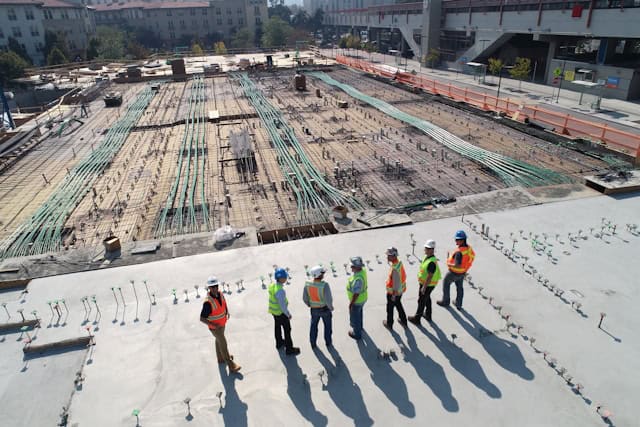The construction industry is in a constant state of change. Currently, it’s happening faster than ever. These days, staying ahead requires more than manpower or experience alone.
As a business owner, you need systems that think alongside you. Intelligent software that can anticipate challenges and help your projects run efficiently. Smart management software provides exactly that.
These futuristic platforms work by connecting every team and workflow. This turns complex operations into achievable results. Now you can breathe a sigh of relief! Why? These platforms bring you complete clarity with every decision you make.
According to a report by Barclays, companies that adopt intelligent tools have a competitive edge. Let’s explore the best platforms that give you visibility in your market. Are you ready to create a solid foundation for growth?
Modern construction project management
Material waste has long been the curse of many construction projects. This waste frequently stems from over-ordering or miscommunication in your team.
It’s time to solve this problem with cutting-edge smart tools. After all, they are designed to make your life easy. You should invest in modern digital systems that tackle this task easily. They can give your managers clear visibility into your:
- inventory levels
- deliveries
- usage patterns
These systems make it possible to compare your planned consumption with the actual usage in fine detail. Especially when combined with BIM-to-BOM mapping and RFID-tagged materials. This comparison will trigger any necessary adjustments automatically. This could include rescheduling deliveries or modifying purchase orders.
These capabilities form the foundation of what many recognize as the best construction management software, like the one made by Fieldwire. They provide you with the necessary insights to reduce surplus and improve your sustainability. All without slowing down your operations or compromising on your high quality.
Synchronize your teams & equipment
Project delays and equipment downtime will drain your budgets and create awkward bottlenecks. Don’t worry, as subcontractor software addresses this issue. Cleverly done by aligning your subcontractor schedules with overall project milestones.
In the background, the system will also monitor your machinery through telematics. These track all your engine hours and their fuel consumption. This synchronization allows your managers to detect potential conflicts early. Then they can adjust the workflows before delays occur.
The system also highlights metrics such as:
- average idle hours
- labor productivity
- equipment utilization
These data points will give teams measurable goals for continuous improvement.

ERP systems for construction
Nowadays, construction projects rely on prefabricated components. This is done so they can accelerate timelines and reduce any on-site labor. So you need an Enterprise Resource Planning system to step in to save the day.
This system is a centralized platform that connects all of your operations within a single interface. Including aspects like:
- production
- supply chain
- inventory
- financial operations
Tools like MRPeasy enhance this process by linking prefabrication operations directly to project timelines. In fact, these systems are particularly useful in construction prefabrication. This is because they prevent failures, such as:
- misaligned schedules
- material shortages
- cost overruns
All of which could commonly occur if your manufacturing and on-site operations operate in isolation.
Quality-to-cost reconciliation
With so many prefabricated components, how can you keep an eye on them all?
Prefabricated components usually move through multiple locations before arriving on your site. Of course, any undetected defects can cause delays. Or even worse, they could increase your costs.
Here, advanced ERP systems help your managers trace each lot. From initial production to final delivery. Also, they effortlessly link:
- supplier details
- inspection results
- component histories
When a discrepancy appears, the system highlights which batches are affected. This visibility helps teams spot problems before they reach the site. Showing exactly which batches need attention.
As a result, your managers can quickly see the cost of these defects. Then they can compare it to your budgeted expectations. Ultimately, they can decide whether to repair, replace, or adjust your future orders.
Smart AI assistants on site
Construction sites generate a constant stream of data from schedules, equipment, and materials. Here, your team may struggle to use this data effectively.
Intelligent assistants solve this problem easily. They achieve this by acting as a hub. They collect and organize the relevant information exactly when it’s needed. Many construction companies are now using AI chatbots to help their teams.
Whatever the query, these chatbots can ensure your workers receive accurate answers.
The system also flags potential delays or hazards as they arise. They can guide decisions before problems escalate in your team.
Field-to-office knowledge transfer
Every day, your construction teams will gather critical observations and safety updates. AI systems capture this information and organize it for you. Afterwards, they deliver actionable summaries to planners and your managers. This ensures that absolutely nothing gets overlooked in your workflow.
When these revolutionary systems detect trends or recurring issues effortlessly. Armed with this knowledge, your office teams can:
- adjust schedules
- reallocate resources
- improve training programs
This continuous feedback loop strengthens safety, efficiency, and sustainable growth across every project to deal with.
Digital marketing strategies for construction
After you have implemented the best kind of smart management software for your company, you can then collect vast amounts of data. This may include:
- project timelines
- material use
- workforce metrics
With all this efficiently organized data, you can turn this into a marketing asset. Your decision makers will be able to see the areas of strongest performance within your company. Then they can translate them into digital campaigns that highlight efficiency and sustainability.
Therefore, we recommend that you integrate these marketing dashboards within your management platforms. This way, your business can automatically push verified data to:
- online profiles
- case studies
- listings
Here, you could employ next-level SEO strategies to cut through the huge amount of digital advertising online. Search algorithms prioritize accurate, measurable information. This will reward your construction company if you can show authentic results.
According to HubSpot, companies with aligned data-driven content strategies see 55% higher web traffic than those relying on manual promotion.

Integrate analytics with customer acquisition systems
One of the biggest driving factors of sustainable business growth is: the connection between marketing and customer relationship management.
Therefore, we suggest you use a Customer Relationship Management (CRM) platform that solves all of your pain points as a brand. These CRMs can link your campaign data directly to your lead tracking systems. At the end of the day, this will ensure that every click or call is logged correctly.
The system lets your marketing teams see the results of their campaigns with great ease. They can view which digital ads generate the best qualified leads. Then they can adjust your budgets based on this conversion efficiency.
This is where you can merge your dashboards with Google Analytics and the project data. Afterwards, they can be converted into helpful reports that display revenue contribution per campaign. This integration will help your construction company allocate resources precisely where digital marketing delivers measurable returns.
Smart lead prioritization with performance data
Many construction firms struggle to separate high-quality prospects from casual inquiries. Mostly because their lead scoring system often relies on marketing engagement alone.
Smart management software changes this by pulling in verified project data. This data will help you refine your CRM evaluation process. It will include metrics like:
- completion consistency
- cost efficiency
- environmental impact
With this shift, your leads will be ranked by interest and compatibility with your company’s strengths. Over time, this data-driven accuracy will drastically reduce your acquisition costs. In addition, it will shorten your response cycle and develop a long-term client trust. Providing the best kind of result: a marketing ecosystem that grows more sustainable with every captured insight.
Fleet telematics and route optimization
It’s a well-known fact that fleet management is a major energy consideration in every construction company. Yours will be no different. Once again, you can make use of smart management software for this task. The software connects telematics all kinds of data, like:
- truck data
- machinery data
- route optimization algorithms
This allows your planners to assign your deliveries and site movements efficiently. Which has a knock-on effect, dramatically reducing your unnecessary travel and fuel consumption.
These systems come equipped with real-time alerts. As they enable your drivers to make dynamic route adjustments when delays or equipment constraints occur.
Thus, if you integrate these insights into your scheduling and logistics modules, you will directly contribute to clear project timelines and sustainable business growth.

Take control of your growth today
Every choice on your construction site carries a huge weight. From resource allocation to environmental impact.
As you have seen, smart management systems can illuminate these decisions. They rapidly turn your everyday operations into opportunities for meaningful improvement. As a leader, you will be able to see the ripple effect of these actions. You may notice that these systems will balance efficiency and profitability with precision.
Over time, this kind of approach will encourage the right environment in your company. One of proactive problem-solving.
Now is the time to use this wonderful technology. Don’t waste a second! Otherwise, you will get left behind in the market.

